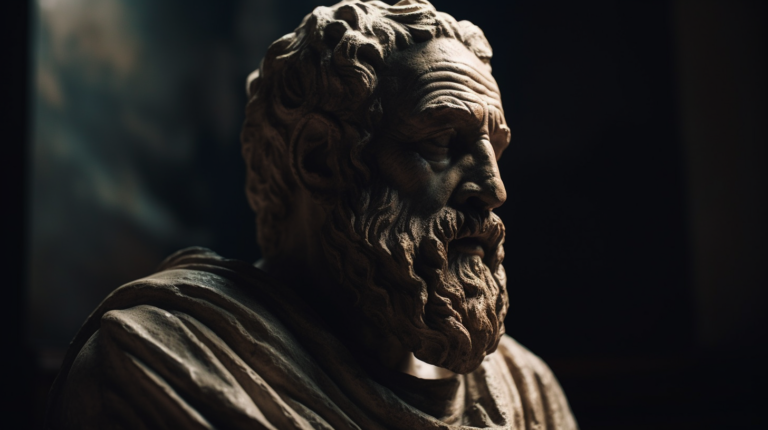What is modern stoicism?
Stoicism is often seen as a philosophy that’s studied as part of classical literature or ancient Greek history, but there’s a whole community of people who still practice the philosophy today.
In a nutshell, modern Stoicism is an adaptation and application of ancient Stoic philosophy for use in the contemporary world.
While it’s true that the world around us has changed dramatically over the last 2000 years, our problems and struggles are much the same.
This means that the philosophies that were used in ancient Rome and Greece to help people live more happily and resiliently can still provide a huge amount of value to us today if we know where to look.
Stoicism, founded in ancient Greece and developed in Rome, is a philosophy that emphasizes virtues like wisdom, courage, justice, and temperance.
It teaches the importance of understanding what is within our control and what isn’t, advocating for a life lived in harmony with nature and reason.
The first rule is to keep an untroubled spirit. The second is to look things in the face and know them for what they are.

How do you practice modern Stoicism?
The Stoics viewed the world around them as a sequence of changing and flowing events. Most of which are completely outside our control.
As participants in these events, our lives are defined by two things:
-
The things that happen around us.
-
How we respond to those events and what values, expectations, and beliefs we develop as a result of what we experience.
This distinction is important because the events that happen around us are very rarely within our control. Meaning that no matter how much we try or suffer, we cannot change them.
However, within our control are our responses, expectations, beliefs, and values. This is where the Stoics instruct us to focus our efforts. Not in changing the world around us, but in changing ourselves so that we can make the best use of what is in our power—our own actions.
The Stoic philosopher Epictetus once said:
There is only one way to happiness and that is to cease worrying about things which are beyond the power or our will.
To help us develop, the Stoic philosophers have left us with a framework with which to examine the beliefs we have about the world and decide whether they are constructive and can be developed or destructive and need to be replaced.
When this process is repeated over days, months, and years, we change our outlook on our surroundings and we change our lives.
So let’s go over some basics to get started.

Stoic Philosophy:
The principles of Stoic philosophy are very simple.
-
Live with virtue (wisdom, justice, temperance, and courage)
-
Overcome destructive emotions through self-control, resilience, and logic.
We can explore each of these at a time and then see why they are still relevant in today’s modern world, 2000 years after the founding of Stoic philosophy under the shade of Athens’ stoa.
Living with Stoic virtue:
The Stoics believed that the path to a good and happy life lies in virtue and how we express virtue in our actions.
The four Stoic virtues are:
-
Wisdom
-
Temperance
-
Courage
-
Justice
Wisdom is necessary to understand right from wrong and good from evil. Wisdom is our ability to see things for what they are, in context, rationally, and without bias.
Only with wisdom can we see the world clearly. Without it, we will always be clouded by our own prejudice, emotion, values, and expectations; we will be unwilling to see things in context and with neutrality.
Without wisdom, justice, temperance, and courage, they become warped and muddied. It is the most important of the virtues.
Temperance is our ability to moderate our behaviour. Temperance is our discipline, our self-control, and our restraint. With temperance, we are able to do what we know we should do rather than what we feel like doing.
Temperance is important for avoiding overeating, too much comfort, and laziness, promoting exercise, work, and good habits, and pushing ourselves outside our comfort zone for growth.
Courage is our ability to do what we believe to be right in the face of fear, anxiety, nerves, and pressures that may otherwise prevent us from doing the right thing.
“I learned that courage was not the absence of fear, but the triumph over it. The brave man is not he who does not feel afraid, but he who conquers that fear.” – Nelson Mandela
Justice is our ability to do what is right for the good of our community, to act fairly, desire fairness, and behave in the spirit of the whole rather than the self or the few.
Stoic Resilience to Destructive Emotion:
The Stoics were renown for self-mastery, and I believe the effectiveness of Stoic philosophy in managing one’s emotions is a large part of why the philosophy is so popular to this day.
I think it’s important to point out that the Stoics did not advocate the cold elimination of emotion but rather learning tools that lessen the impact that emotion can have on our lives.
The most popular Stoic principle for this is the dichotomy of control championed by the Stoic philosopher Epictetus, who wrote:
“Some things are within our power, while others are not. Within our power are opinion, motivation, desire, aversion, and, in a word, whatever is of our own doing; not within our power are our body, our property, reputation, office, and, in a word, whatever is not of our own doing.”
The dichotomy of control outlines the following:
-
We should take full responsibility for the things in life withing our control:
-
Our thoughts & perceptions
-
Our beliefs
-
Our values
-
Our actions
-
-
We should accept the things outside our control:
-
Other people
-
The weather
-
Nature
-
Time
-
The economy
-
Traffic
-
Respect & Reputation etc
-
“There is only one way to happiness and that is to cease worrying about things which are beyond the power or our will. ”
– Epictetus

Stoicism For Modern Life:
The lives we live today are very different to the lives lived by the ancient Greeks and Romans. We have the challenges of navigating tech like social media, busy office lives, global communication, and information overload, while the ancients were more threatened by disease, war, famine, slavery and other challenges that have lessened over the years as society has developed.
However, there is still a large amount of common ground.
While the challenges we face may have changes a little over time, the way we process them has not. We still suffer in the same way the Romans and Greeks did, regardless of whether it is due to a high level job interview, a difficult divorce, or being exiled from our home by a tyrannical Emperor.
The Stoics didn’t simply develop solutions to specific problems, they created tools to deal with how we respond to problems, the way humanity processes and perceives adversity and hardship.
For this reason, the lessons from Stoic philosophers are as relevant today as they were 2000 years ago.
Stoic Practices For Modern Life:
1. Stoic Journaling
The practice of journaling was promoted by Marcus Aurelius, Seneca, and Epictetus.
These ancient Stoic philosophers knew that writing and reflecting on one’s day was one of the best ways we can process our thoughts, feelings, and emotions, as well as how we react and respond to the events we find ourselves in.
The journal of Marcus Aurelius is one of the most prominent Stoic texts that we have from the ancient Stoic philosophers. It wasn’t intended to be read by anyone other than the Emperor himself; however, in it’s pages, we find how valuable self-reflection can be.
In our modern world, journaling still holds it’s value. All we need is a pen, a notebook, and the time to sit down and reflect on how we feel our day went.
2. Meditation
Meditation is promoted across multiple different ideologies and cultures as a way to quieten the mind, improve focus, lessen stress, and generally increase our well-being.
The Stoics used meditation as was way to reflect on a number of different things like:
-
How we respond to challenges
-
Whether or not we are virtuous in our actions
-
Deciding what is and what is not within our control
-
Whether or not our problems are really problems, or are we making the problems ourselves
-
Visualisation
3. Stoic Visualisation
The Stoics promoted the practice of negative visualisation, or premeditatio malorum, in order to lessen the suffering that can be caused by hardship and suffering.
Negative visualisation is the practice of putting yourself at some point into the future, perhaps a challenging situation you think you will have to face, or a difficult decision you will have to make.
While imagining yourself in that situation, you then visualise the worst case scenario, how you respond to it, and how you would live after it has passed.
In many cases, we suffer in anticipation of a bad thing rather than suffering because of the bad thing. Negative visualisation helps us lessen this suffering and helps us process the stress that comes with anticipation and anxiety.
FAQ: Understanding Modern Stoicism
What is Modern Stoicism?
Modern Stoicism is the contemporary adaptation of ancient Stoic philosophy. It applies Stoic principles of virtue, rationality, and control over one’s inner life to modern day challenges, aiming to enhance personal well-being and resilience.
How Does Modern Stoicism Differ from Ancient Stoicism?
While based on ancient Stoic teachings, Modern Stoicism is tailored for contemporary life. It addresses modern issues such as technology, fast-paced lifestyles, and complex social dynamics, while being more inclusive and accessible to a diverse audience.
Can Modern Stoicism Help with Stress?
Absolutely. Modern Stoicism offers tools for managing stress, such as distinguishing between what’s within our control and what’s not, and responding to situations with rationality and calmness. This approach can significantly reduce feelings of stress and anxiety.
Is Modern Stoicism Religious?
Modern Stoicism is not inherently religious. It’s a practical philosophy focused on ethical living and mental resilience. However, its principles can complement various religious beliefs and are accessible to individuals of any or no religious background.
How Do I Practice Modern Stoicism?
Practicing Modern Stoicism involves daily habits such as reflective journaling, mindfulness exercises, and contemplation of Stoic teachings. Engaging with both ancient texts and modern interpretations of Stoicism also helps deepen the practice.
What are the Core Virtues of Modern Stoicism?
The core virtues of Modern Stoicism are wisdom, courage, justice, and temperance. These virtues guide individuals towards ethical behavior, rational decision-making, and emotional resilience.
Does Modern Stoicism Advocate Emotional Suppression?
No, Modern Stoicism does not advocate for suppressing emotions. Instead, it teaches understanding emotions through a rational lens and responding to them in a constructive manner, rather than being controlled by them.
How Can Modern Stoicism Improve Relationships?
Modern Stoicism can enhance relationships by fostering virtues like patience, understanding, and empathy. It encourages seeing situations from others’ perspectives and responding with reason rather than impulsive emotions.
Where Can I Learn More About Modern Stoicism?
There are many resources available for learning about Modern Stoicism, including books, online courses, podcasts, and community forums. Engaging with both ancient Stoic texts and contemporary writings on the subject can offer a comprehensive understanding.
Is Modern Stoicism Suitable for Everyone?
Yes, Modern Stoicism is adaptable and can be beneficial for people from all walks of life. Its principles are universal and can be applied regardless of one’s personal circumstances or background.







All content was inspiring. I Most Liked it all! Would like more